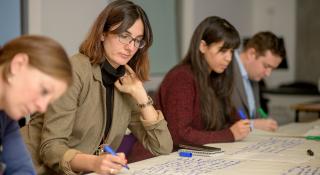
Breadcrumbs navigation
‘No buildings from September: what on earth do we do about the learning experience’? – event takeaways and reflections
Chrissie Duxson, BISA’s Communications Manager, reflects on the recent one-day conference from Aula and WonkHE.
Earlier this month I attended my first virtual conference, run by Aula and WonkHE - ‘No buildings from September: what on earth do we do about the learning experience?’ I wasn’t relishing the prospect of a day on Zoom, but it gave me the opportunity to see what online learning might be like.
If I had to tell you just two things I took from the day, they would be:
- Before we can start teaching online, we need to teach students how to learn online
- I have no idea how to learn online, but I’m a visual learner and really missed having slides, images or something else to help me take in the content.
What does the crisis teach us about the learning experience of the future? - a social science perspective
The first breakout session I attended, given a choice of four, covered the learning experience of the future from a social science perspective. Five things I took from this session were:
- There will be a gap to close for new students in September as they have missed out on experiences due to the pandemic, as well having a six-month hiatus from study
- Monitoring engagement during online sessions is going to be hard with more than 25 students (the maximum you can see in a Zoom window at one time). Therefore, the emphasis will have to be on monitoring what students do outside the classroom. Some students will find it hard to speak online during the session, even in the chat, for a variety of reasons, but it doesn’t mean they aren’t engaged so measuring engagement that way won’t work
- This crisis is the moment to make changes that will last, not just changes for a season
- We can’t lose focus on building relationships between staff and students
- Teaching online is different to face-to-face and the suggestion was to remove some content from your lectures and make some of this interactive instead.
Interactive wrap up
Following the first of the breakout sessions I took part in a wrap up session using a platform called Padlet. This was an interactive exercise akin to collaborative writing on a flipchart or whiteboard. It worked really well and I’d thoroughly recommend looking into using Padlet for teaching. You could see the ‘board’ update in real time as people added their ideas, you could vote on ideas by ‘liking’ them, and, best of all in my opinion, you couldn’t see who had written which idea. This made it a safe environment to engage - whether you’re a native English speaker or not, and if you wanted to test an idea you weren’t sure about.
A band aid or a 10-year education strategy with three months to execute?
This second breakout session started with a case study from Dr Stefanie Lindquist - Senior Vice-President of Global Academic Initiatives at Arizona State University. She showed a video of a partially virtual graduation and, honestly, it blew my mind. A stand on wheels appeared with a tablet on top. It was connected via Zoom to a student in another location, who was able to cross the stage virtually to be presented with their degree certificate scroll.
Stefanie went on to say that at Arizona State they have upskilled their faculty and will use Zoom technologies into the future. They were prompted to do this following a crisis in 2006, rather than by the current situation. They wrap their online teaching with internships, learning support, and community-focused activities.
The other things I took from this session were:
- Now more than ever we have to see students as co-creators
- The technology is there to make online teaching interactive and accessible, and to build a sense of community. The experience of online learning should be challenging, authentic and collaborative
- We have to be realistic about what can be achieved in the next three months, but at the same time still ensure that we live up to the promise made to students about their experience. This is going to be a tall order!
- In order to generate interactive blended learning we need to think about the interests and skills of staff, and the availability of technology for the students
- Currently many of us are seeing technology as either a problem or a solution. It’s actually how we use technology that will produce the solution, not the technology itself.
Afternoon keynote
During this session, Ian Dunn from Coventry University predicted that in five years time students will be able to engage with courses either all on campus, or all online, or choose any mix of the two. It was also said that some students were already broadcasting lectures to other students using platforms such as Facetime before the pandemic started, so perhaps students are actually keen to embark on more online learning.
Susan Jeffords from Portland State University also spoke in this session and discussed Portland’s research which shows that being able to switch between online and on campus increases persistence.
How to save students from death by powerpoint
There wasn’t actually much related to powerpoint in this session, it was more of a general discussion around technology platforms and student experience. My key takeaways were:
- Come September students won’t accept the pandemic as an excuse for poor experience and teaching, so there is an urgent need to upskill staff
- Academics who are experienced in online learning tend to use the platforms where they know students already are e.g. Tiktok, WhatsApp and YouTube. They also give students tasks to do outside of contact time, for example listening to a podcast
- To aid accessibility and inclusivity academics are using the Ally plugin for Blackboard. This uses a traffic light system to allow you to find out if the materials you upload are accessible. Ally themselves describe it as ‘a revolutionary product that integrates seamlessly into the learning management system and focuses on making digital course content more accessible’. It certainly sounds good.
- There is a need to safeguard peer to peer conversations
- The devolved nature of universities is confusing for students as different departments are saying different things but students know each other across departments and compare information (clearly this is not news, but still relevant during this crisis)
- Students will continue to need a sense of belonging and something they can all relate to.
Conclusions
At the end of the event I was left thinking about some important questions:
- How can we replace the social aspect of lectures?
- Will students still develop emotional intelligence during their time at university after moving to online learning?
- How will we create a sense of community?
- How will we provide students with the quiet spaces they need to study if they can’t go to campus?
- What can we do about digital poverty? The government partially addressed laptops in a Q&A on Wednesday 6 May, but what about the ongoing cost of broadband, software licences and other equipment? We’ve spent the recent past ensuring there is a digitally enabled and inclusive campus, but this crisis has exposed the need to address needs of students off campus.
Reflecting back on the day as a whole, most of the speakers were in management or strategy rather than on the front line delivering the day-to-day practicalities. However, there was some sound advice, an introduction to some new technology platforms, and plenty to get us thinking about September.
More information about the conference and the session recordings can be found on the event page.
Photo by Andrew Neel on Unsplash


